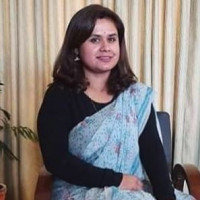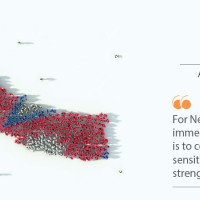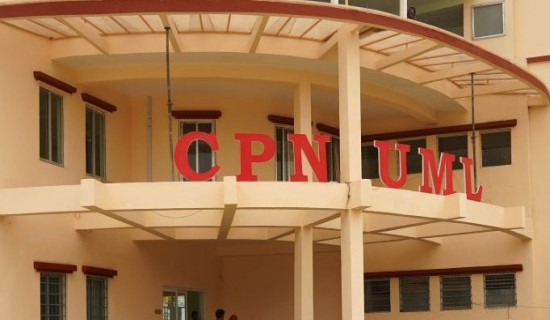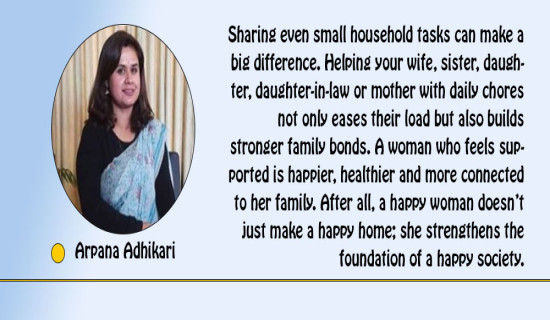- Saturday, 29 November 2025
Women Catalysts For Socio-Political Transformation
Throughout the history of Nepal, there have been multiple political movements in an attempt to restore democracy. Regardless of challenging conditions, women have taken part in movements like the first and second people's movements.
These women have acted themselves as catalysts for social and political transformation.
After the 1951 political upheaval, female participants started to campaign for their right to vote and to be elected into public office. This resulted in Sadhana Devi Pradhan becoming Kathmandu Municipality's elected female representative in 1953.
Women’s Participation
Furthermore, Nepal made another ground-breaking advance in 1959 when Dwarika Devi Thakurani became the nation's first woman minister for the democratic government led by late BP Koirala. Women's political engagement became increasingly prominent with the re-establishment of multi-party democracy in 1990.
The same year, the constitution was implemented, and it was the first to allow for at least 5 per cent female representation in the House of Representatives (HoR), as well as three women in the National Assembly.
Nepal has just one female lawmaker elected in the general election of 1959, Dwarika Devi Thakurani. Since then, Nepal has seen a considerable growth in the number of women in parliament. Nepali voters elected eight female legislators in 1991, seven in 1993, twelve in 1999, 197 in 2008, 176 in 2013, 90 in 2017, and 91 in 2018.
Similarly, in the 1992 local elections, women accounted for 0.48 percent of the representation, whereas in the 1997 local elections the number of women climbed to 9.85 per cent. After three decades, the proportion of women in local government has reached 41.22 per cent, with 25 elected to top posts.
Because women are under-represented in all political entities, the 2015 constitution mandated comprehensive proportional participation of women in all government bodies as a basic right of women.
According to Article 84(8) of our constitution, at least one-third of the total parliamentarians chosen from each political party represented in parliament must be women. As a consequence, women currently constitute 33.9 percent of the House of Representatives (HoR) and 36.36 percent of provincial assemblies (PA).
At 33 percent in the two chambers of the Federal Parliament, Nepal much above the global average of 26.5 percent female lawmakers.
The average for Asian countries is 21.2 percent, and 16.5 percent for South Asian countries.
In the IPU's January 2023 worldwide data on national legislatures, Nepal is rated 53 out of 186 nations, trailing Bangladesh (107), Pakistan (110), Bhutan (131), India (140), Sri Lanka (179), and the Maldives (180).
During the country's transition to federalism, there has also been a major improvement in women's representation at the municipal level. When the country implemented federalism, two local polls were held, in which women's representation reached 41 percent, 40.96 percent in 2017 local polls, and 41.22 percent in 2022.
Women from marginalised populations like as Madhesi, Dalits, Muslims, and Tharus are now participating in decision-making processes, including in province and municipal government organisations.
Women in Nepal are now in charge of local judicial committees after breaking down all barriers to equality. Nepal is one of the world's few countries with a female president.
Despite being a profoundly patriarchal country, Nepal elected its first female Speaker of the Legislature-Parliament in 2015, and in 2016, Nepal elected its first female Chief Justice, ending male dominance in senior judicial positions. Activists praised these steps as a watershed moment for women's empowerment in Nepal.
Despite significant progress in securing political rights for women, who account for around 51 percent of the country's population, female involvement in Nepali politics and parliament remains at a bare minimum.
The number of women lawmakers in the House of Representatives is just 33.09 percent, a miniscule crossing of the constitutionally mandated criterion of 33 percent reservation for women in the Parliament.
The 2022 local election saw a minor gain in the number of elected women representatives and chief posts (from 17 to 25 chiefs), but a major reduction in the number of women deputy chiefs, with 564 women elected to the post. In 2017, this figure was 700.
As a result, the country fell short of its target of having half of its local legislators be women.
Also, the country saw a considerable increase in the number of female legislators in the 2008 Constituent Assembly election but failed to sustain the number in consecutive legislative elections. That was conceivable in 2008 because the Maoist party, which had just entered mainstream politics, fielded a larger number of female candidates in the direct election.
When it came to the direct election, however, none of the political parties seemed progressive in terms of sending higher number of female members to the elected bodies.
According to the Election Commission's data, just 9 percent of federal candidates are women, with 8 percent of provincial legislatures fielding candidates under the first-past-the-post (FPTP) voting system. Moreover, only 25 women from the ruling coalition led by the Nepali Congress and the opposition alliance led by the UML were given the option to run in direct elections to the House of Representatives. Nepalese parties are hesitant to field women under the FPTP system, and women are placed on the proportional representation (PR) list to maintain constitutional compliance.
Pushpa Bhusal, a former deputy speaker and key leader in the NC, previously blamed poor female representation in the direct voting system on male-dominated party structures, society's patriarchal worldview, and a lack of a gender-friendly electoral system.
Gradual Progress
Because all party committees, from the ward to the central level, are male-dominated, women's candidatures in direct elections are denied. She stated that they feel women cannot win in a direct election and acknowledged that one of the key causes of women's underrepresentation is a lack of women-friendly election procedures, such as costly campaigning and the power of money and muscle.
Earlier, constitutional analyst Bipin Adhikari told The Rising Nepal that political parties' opening up space for women's involvement in electoral politics has been gradual due to the parties' deep-rooted structural restrictions, which are male-dominated.
A constitutional mandate of 33% female representation in parliament exists.
Yet, achieving a truly equal society and true democracy requires more than just meeting the mandated requirements set in place. Women need to be actively empowered and encouraged to participate in the political process in order to make sure their voices are heard and their representation is felt in government decision-making roles.
This is particularly important due to the fact that women have historically had lower representation in high-level positions of power. There needs to be an effort from all aspects of society in order to create an environment that not only meets the 33 per cent female participation requirement but also creates a culture of acceptance and support for those challenging the status quo. Only then can we move towards creating a more equitable nation.
The contribution of women in politics should not be underestimated or ignored. Political parties must take meaningful steps to guarantee equal participation for female citizens and make sure that their voices and perspectives are heard in order to strengthen democracy. This is paramount for addressing social issues, protecting civil rights, and preserving political freedoms for all citizens.
(Adhikari is a journalist at this daily)
How did you feel after reading this news?

















